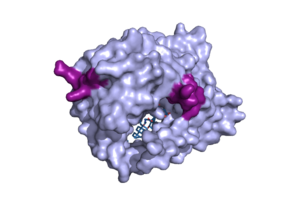Sandbox Reserved 1782
From Proteopedia
(Difference between revisions)
| Line 17: | Line 17: | ||
* <scene name='95/952711/Sodium_residue_zoom_in_nctp/1'>Sodium binds to specific residues within NTCP </scene> such as . The binding pocket forms a tunnel structure within NTCP at the interface of two domains that connects the external cytoplasm of the hepatocyte to the basolateral membrane. The face of the tunnel where the bile salts bind is lined with hydrophilic residues, whereas the opposite face of the transmembrane helices is hydrophobic, making the tunnel amphipathic. <Ref name="Liu"> Liu, H., Irobalieva, R.N., Bang-Sørensen, R. et al. Structure of human NTCP reveals the basis of recognition and sodium-driven transport of bile salts into the liver. Cell Res 32, 773–776 (2022). [https://doi.org/10.1038/s41422-022-00680-4 DOI: 10.1038/s41422-022-00680-4]. </Ref> The hydrophilic tunnel allows hydrophilic bile salts and sodium ions to be transported across the hydrophobic cell membrane. In the <scene name='95/952710/Tunnel_front/1'>outward facing state</scene> with no bile salt bound to the tunnel, it forms a hollow hole in the middle of the structure. When bile salts bind within, these bile salts completely occlude the <scene name='95/952710/Bile_bound_to_tunnel/2'>tunnel</scene>. | * <scene name='95/952711/Sodium_residue_zoom_in_nctp/1'>Sodium binds to specific residues within NTCP </scene> such as . The binding pocket forms a tunnel structure within NTCP at the interface of two domains that connects the external cytoplasm of the hepatocyte to the basolateral membrane. The face of the tunnel where the bile salts bind is lined with hydrophilic residues, whereas the opposite face of the transmembrane helices is hydrophobic, making the tunnel amphipathic. <Ref name="Liu"> Liu, H., Irobalieva, R.N., Bang-Sørensen, R. et al. Structure of human NTCP reveals the basis of recognition and sodium-driven transport of bile salts into the liver. Cell Res 32, 773–776 (2022). [https://doi.org/10.1038/s41422-022-00680-4 DOI: 10.1038/s41422-022-00680-4]. </Ref> The hydrophilic tunnel allows hydrophilic bile salts and sodium ions to be transported across the hydrophobic cell membrane. In the <scene name='95/952710/Tunnel_front/1'>outward facing state</scene> with no bile salt bound to the tunnel, it forms a hollow hole in the middle of the structure. When bile salts bind within, these bile salts completely occlude the <scene name='95/952710/Bile_bound_to_tunnel/2'>tunnel</scene>. | ||
| - | The NTCP binding pocket represents a "tunnel" lined with hydrophilic residues within the NTCP structure to allow hydrophilic bile salts and sodium ions to bind. When there are no bile salts bound to NTCP's binding tunnel, it forms a hollow hole in the middle of the structure, from <scene name='95/952710/Tunnel_front/1'>front</scene> to <scene name='95/952710/Tunnel_front/3'>back</scene>. As bile salts bind to this binding pocket, the bile salts very nicely fill the hole within NTCP and fit almost perfectly within the tunnel, to the point where the <scene name='95/952710/Bile_bound_to_tunnel/2'>tunnel</scene> can no longer be seen, as it is completely encompassing the bile salts. <scene name='95/952711/Sodium_residue_zoom_in_nctp/1'>Sodium binds to specific residues within the molecule. </scene> This tunnel formed connects the external cytoplasm of the hepatocyte to the inner leaflet of the basolateral membrane. The side of the tunnel where the bile salts bind are lined with hydrophilic residues, whereas the opposite side of the helix is lined with hydrophobic residues, as the transmembrane helices are amphipathic. <Ref name="Liu"> Liu, H., Irobalieva, R.N., Bang-Sørensen, R. et al. Structure of human NTCP reveals the basis of recognition and sodium-driven transport of bile salts into the liver. Cell Res 32, 773–776 (2022). [https://doi.org/10.1038/s41422-022-00680-4 DOI: 10.1038/s41422-022-00680-4]. </Ref>. | ||
[[Image:Patches.png|300 px|left|thumb|'''Figure 2.''' Surface representation of the NTCP molecule with both patches shown. Patch 1 can be seen on the left side of the molecule, whereas patch 2 is located on the right side within the binding tunnel. PDB file 7ZYI.]] | [[Image:Patches.png|300 px|left|thumb|'''Figure 2.''' Surface representation of the NTCP molecule with both patches shown. Patch 1 can be seen on the left side of the molecule, whereas patch 2 is located on the right side within the binding tunnel. PDB file 7ZYI.]] | ||
Revision as of 17:21, 10 April 2023
| This Sandbox is Reserved from February 27 through August 31, 2023 for use in the course CH462 Biochemistry II taught by R. Jeremy Johnson at the Butler University, Indianapolis, USA. This reservation includes Sandbox Reserved 1765 through Sandbox Reserved 1795. |
To get started:
More help: Help:Editing |
human Sodium Taurocholate Co-transporting Polypeptide (NTCP) structure
| |||||||||||
References
- ↑ Goutam, K., Ielasi, F.S., Pardon, E. et al. Structural basis of sodium-dependent bile salt uptake into the liver. Nature 606, 1015–1020 (2022). DOI: 10.1038/s41586-022-04723-z.
- ↑ Maldonado-Valderrama, J., Wilde, P., Macierzanka, A., & Mackie, A. (2011). The role of bile salts in digestion. Advances in colloid and interface science, 165(1), 36–46. DOI: 10.1016/j.cis.2010.12.002.
- ↑ 3.0 3.1 3.2 Asami J, Kimura KT, Fujita-Fujiharu Y, Ishida H, Zhang Z, Nomura Y, Liu K, Uemura T, Sato Y, Ono M, Yamamoto M, Noda T, Shigematsu H, Drew D, Iwata S, Shimizu T, Nomura N, Ohto U. Structure of the bile acid transporter and HBV receptor NTCP. Nature. 2022 Jun; 606 (7916):1021-1026. DOI: 10.1038/s41586-022-04845-4.
- ↑ Liu, H., Irobalieva, R.N., Bang-Sørensen, R. et al. Structure of human NTCP reveals the basis of recognition and sodium-driven transport of bile salts into the liver. Cell Res 32, 773–776 (2022). DOI: 10.1038/s41422-022-00680-4.
Student Contributors
- Kenna King
- Tatiana Pereda
- Olivia Simcox
![Figure 1. NTCP structure with both Na+ ions and bile salts bound with the NTCP molecule shown in light blue, the two Na+ ions shown in purple spheres, and the bile salts shown in sticks as dark blue. [PDB file 7ZYI].](/wiki/images/thumb/7/7d/CARTOON.png/400px-CARTOON.png)

